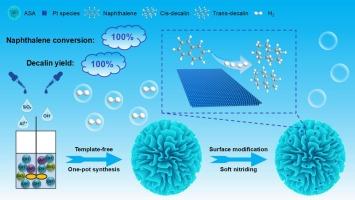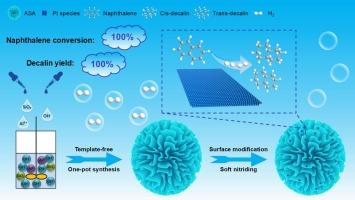One-pot template-free green synthesis of mesoporous amorphous silica-alumina for enhanced hydrogen storage in naphthalene
IF 6.5
1区 化学
Q2 CHEMISTRY, PHYSICAL
引用次数: 0
Abstract
Amorphous silica-alumina (ASA) with ultra-high specific surface area and suitable pore structure was successfully synthesized through the development of a cost-effective and efficient one-pot synthesis method under template-free conditions. Then Pt-loaded ASA catalysts with suitable acidity and highly dispersed Pt species were prepared via a synergistic strategy combining surface modification and “soft” nitriding. Among the as-designed Pt-loaded ASA catalysts, Pt/ASA catalyst prepared via boron modification and “soft” nitriding (Pt/BNASA) demonstrated outstanding naphthalene hydrogenation performance, achieving complete naphthalene conversion (100 %) and full decalin selectivity (100 %), along with a reaction rate constant (k) of 16.4 × 10−6 mol g−1 s−1 and a turnover frequency (TOF) value of 2415 h−1. The superior naphthalene hydrogenation activity and selectivity of Pt/BNASA catalyst could be attributed to the combination of the excellent textural properties, and the optimized balance between acidic sites and metallic sites.


一锅无模板绿色合成增强萘储氢的介孔非晶硅-氧化铝
在无模板条件下,成功合成了具有超高比表面积和合适孔隙结构的非晶态硅铝(ASA)。然后通过表面改性和“软”氮化相结合的协同策略制备了具有合适酸度和高度分散Pt物种的负载Pt的ASA催化剂。在设计的负载Pt的ASA催化剂中,通过硼改性和“软”氮化制备的Pt/ASA催化剂(Pt/BNASA)表现出优异的萘加氢性能,实现了完全的萘转化率(100%)和完全的十烷选择性(100%),反应速率常数(k)为16.4 × 10−6 mol g−1 s−1,转换频率(TOF)值为2415 h−1。Pt/BNASA催化剂具有优异的萘加氢活性和选择性,这可能是由于其优异的结构性能和优化的酸位和金属位平衡的结合。
本文章由计算机程序翻译,如有差异,请以英文原文为准。
求助全文
约1分钟内获得全文
求助全文
来源期刊

Journal of Catalysis
工程技术-工程:化工
CiteScore
12.30
自引率
5.50%
发文量
447
审稿时长
31 days
期刊介绍:
The Journal of Catalysis publishes scholarly articles on both heterogeneous and homogeneous catalysis, covering a wide range of chemical transformations. These include various types of catalysis, such as those mediated by photons, plasmons, and electrons. The focus of the studies is to understand the relationship between catalytic function and the underlying chemical properties of surfaces and metal complexes.
The articles in the journal offer innovative concepts and explore the synthesis and kinetics of inorganic solids and homogeneous complexes. Furthermore, they discuss spectroscopic techniques for characterizing catalysts, investigate the interaction of probes and reacting species with catalysts, and employ theoretical methods.
The research presented in the journal should have direct relevance to the field of catalytic processes, addressing either fundamental aspects or applications of catalysis.
 求助内容:
求助内容: 应助结果提醒方式:
应助结果提醒方式:


